Is sustainable aviation fuel set to take flight?
The world’s first transatlantic flight using 100% sustainable aviation fuel (SAF) took off from London’s Heathrow airport and landed in New York’s John F. Kennedy Airport in November last year. Some airlines have launched services with the option of selecting a supplementary Sustainable Aviation Fuel Package presenting travellers with the option to choose 0-100% SAF – all for an extra cost. Would you buy this service? Would you be confident you know what are paying for? Are we going to see more airlines offer these types of packages? How much extra are you willing the spend to fly sustainably?
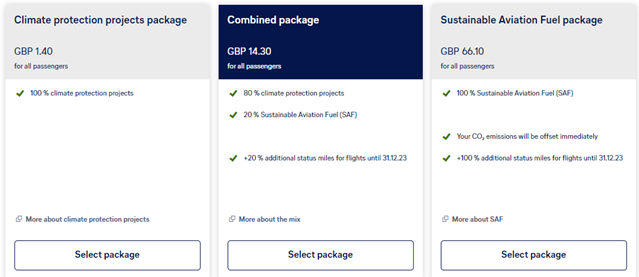
Alternatives to conventional jet fuel
In the UK, both domestic and international aviation sectors were responsible for nearly 8%1 of national carbon dioxide (CO2) equivalent emissions, while in the US, the aviation industry contributed to around 3% of the nation's total greenhouse gas output. Globally, aviation accounted for almost 2.5% of the world's CO2 emissions.
To reduce the carbon footprint of the aviation sector, conventional jet fuel will need to be replaced by fuels with a lower carbon intensity. From a technology standpoint, aviation has relatively few options to replace oil-based fossil fuel and for this reason the sector is termed “hard-to-abate.” Alternatives to conventional jet fuel include battery-electric, hydrogen, and SAF.
With the low energy density and high weight of batteries, battery-electric is only a realistic propulsion option for short-haul flights and medium-to-long-haul flights will require hybrid-electric solutions. Currently, battery-electric aircrafts occupy a small space in the market and to take a larger share, improvements in battery energy density are required. Hydrogen (both gaseous and liquid) supplied to fuel cells onboard airplanes can generate electrical power. However, the low volumetric energy density of hydrogen means that aircrafts would require large fuel tanks for onboard storage and this would call for a significant variation from current airplane design. The use of either battery-electric or pure hydrogen as an alternative fuel will require major new designs of aircraft, including modifying gas-turbine engines. Due to the long operating life of aircraft, the implementation of new designs can take at least 20 years, hence both these alternatives to fossil-based fuel are not expected to have high uptake in the short-to-medium term.
Our UK Energy Transition Outlook 2024 forecasts that the share of petroleum-based aviation fuel is expected to decline to 53% of the energy mix by 2050.
However, SAF can be integrated into the current design of aircraft jet turbines, making it a “drop-in” fuel. Additionally, SAF is projected to reduce greenhouse gas emissions by 50% or more throughout its life cycle, as compared to conventional jet fuel. These properties make SAF a vital component in the energy transition of the aviation industry, with sustainable-based fuels contributing a significant proportion of the fuel mix in the short-to-medium term.
What is SAF?
SAF is the collective term for jet fuel produced from sustainable feedstocks, which can be defined as Biofuel, Renewable Fuels of Non-biological Origin (RFNBO), such as e-fuel, or Recycled Carbon Fuels (RCF).
In terms of fuel characteristics, it is similar to the conventional jet fuel produced from fossil fuel, but not identical. Presently, the maximum blending level of SAF with conventional jet fuel is 50% by volume. The blending limit is in place due to the slight differences in chemical and physical composition of neat SAF compared to jet fuel derived from fossil fuels. Nonetheless, by following the aviation industry standards like American Society for Testing Materials (ASTM), the production of SAF can maintain similar physical properties to conventional aviation fuel. This allows for the use of existing infrastructures, including combustion engine, transportation, and storage, making it easier to integrate SAF into the current aviation market without requiring significant capital investment for existing users.Currently, there are 7certified pathways under ASTM D7566:
Table 1 ASTM D7566 certified pathways
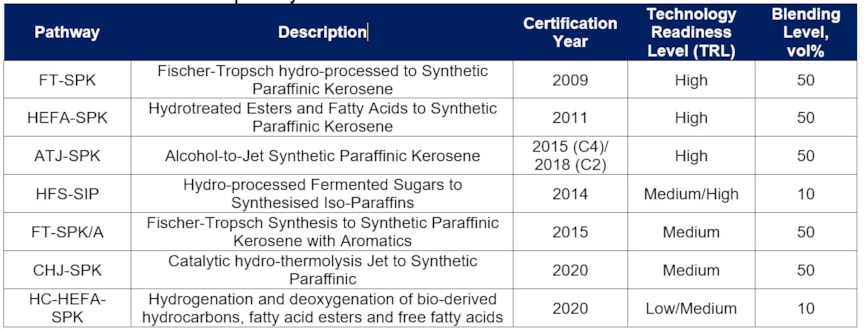
There are many other emerging pathways and technologies which are currently going through the ASTM certification process. Typically, pathways that were certified earlier have a higher TRL as the pathways have reached commercialization. Different SAF production pathways can utilize the same raw feedstock. However, each pathway is unique and produces SAF with slightly different chemical and physical characteristics. This means that the blending level with conventional jet fuel is different for each process. For example, HEFA-SPK has a higher blending rate than HC-HEFA-SPK (50 vol% versus 10 vol%).
Future demand of SAF
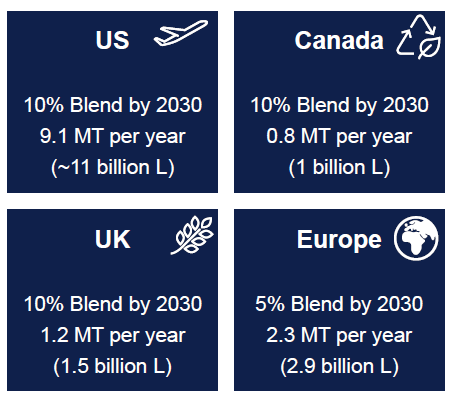
Countries across the world have announced SAF blending targets, stipulating percentage targets of the total fuel mix which must be met through SAF by 2030 (Figure 2).
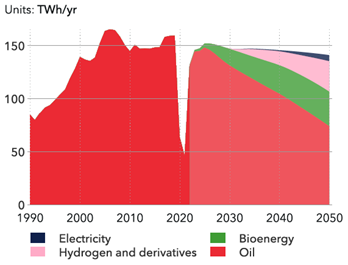
Historical data source: DNV UK Energy Transition Outlook (2024),
IEA WEB (2023), BEIS DUKES (2023)
The UK is introducing a SAF mandate requiring at least 10% (1.5 billion L) of jet fuel to be made from sustainable sources by 2030, with increasing proportions of SAF being blended at 2% from 2025. This is reflected by the increased usage of SAF as an energy carrier for the UK aviation (Figure 3). Aviation fuel suppliers will be incentivized to increase the SAF proportion in their jet fuel supply through credits/certificates. The mandate is still within the draft phase. However, to qualify for credits, SAF must achieve a minimum greenhouse gas emission reduction compared to fossil fuel value and the feedstocks must be waste-derived biofuels, recycled carbon fuels, or renewable Power-to-Liquid (e-fuel).
Current estimates of the SAF market ranges from US$ 84.7 million to US$ 216 million which is projected to grow to US$ 10-20 billion by 2030. The large range can be attributed to many factors, including the relative infancy of the current SAF market and the expected take-up in supply and demand due to net zero targets and subsequent fuel blending mandates that are to be established across the world.
Scaling SAF to meet future demand: Feedstock availability
Globally, there are already a handful of SAF production plants in operation and there is a significant number more within the development stage. Many of those operational plants were based on the HEFA-SPK, ATJ-SPK, and FT-SPK production routes. For example, the Neste refinery in Porvoo, Finland, uses waste oils in a HEFA-SPK process to produce 100,000 tons per annum (tpa) of SAF2. In the US, Lanza Tech’s Freedom Pines in Georgia uses the first generation of ethanol as feedstock in an ATJ-SPK process, yielding ~30,000 tpa of SAF3. Similarly, Fulcrum’s Sierra plant in Reno, Nevada, uses household waste as feedstock in an FT-SPK process, producing 33,311 tpa of synthetic fuel4.
With the reduced pool of alternative fuels that can be deployed in the short term for aircraft and considering the substantial number of SAF projects expected to start production by the end of the decade, the SAF market is going to undergo rapid expansion, so we can expect more airlines offering SAF flights in the future. According to the International Air Transport Association (IATA), the global production of SAF in 2024 is expected to increase significantly and almost triple the production rate in the previous year. In 2023, SAF production reached approximately 0.5 MTPA, which is double the production rate of the previous year. The scaling up in production this year is likely to account for just over 0.5% of the aviation fuel demand5.
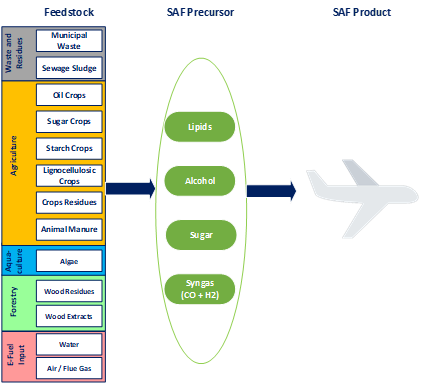
In the long term, SAF production pathways that rely on vegetable oil and first-generation bioethanol may struggle to compete in the market, largely because these feedstocks can have high carbon intensity (due to land use and cultivation-based emissions, etc.) as well as coming under the food versus fuel debate. This is also recognized by the European Parliament which specified that until 2034, SAF produced from food and feed crops do not qualify as SAF6.
Hence, this encourages investment in SAF that is derived from waste oils, lignocellulosic wastes, municipal/industrial wastes, Aqua-culture, sewage sludge, carbon inputs (flue gas/air) and renewable power. SAF will not only originate from more readily available feedstock, but they can be less carbon-intensive compared to first generation bioethanol and vegetable oils, and some even contribute to a circular economy.
Waste cooking/animal oils have been popular for fuel production purposes like biodiesel and jet fuel. However, their use in the UK and Europe could be challenging because of their current import reliance on existing biofuel production. Nonetheless, the lucrative nature of waste oil collection is expected to increase global collection efforts.
On the other hand, lignocellulosic wastes and marine species are more abundant and are not in direct competition with food. There has also been an increasing interest in E-fuels/Power-to-Liquid (PtL) derived from electrolytic hydrogen and CO2 inputs. Germany for example, has set a more stringent target of 2% SAF based on PtL pathway, with a US$75/GJ penalty for non-compliance7.
In order to scale up the production of fuel precursors like lipids/fatty oils, alcohol or syngas from such abundant and sustainable feedstocks that are better suited for long-term solutions, a substantial investment in technology development and operational optimisation is necessary.
Is SAF going to take flight?
The promises made by governments globally through incentives and the scale of SAF projects within development means that the SAF market is going to undergo rapid expansion in the short-to-medium term, meaning that airlines will be more likely to offer SAF packages in the near future. Other alternatives to conventional jet fuel, such as battery-electric and hydrogen, are not expected to play a large role in the short term due to the major redesign of aircraft required.
SAF can be made through many different pathways and through the utilization of many feedstocks. The selection of pathway and feedstock will considerably vary the carbon intensity and cost of SAF significantly. The production cost of SAF derived from various feedstocks via different pathways can range from 1.4 to 7 times higher than the conventional jet fuel which is ~$800 per tonne8. The International Energy Agency (IEA) has calculated that a 10% of SAF blend would only increase the aviation industry’s fuel bill by 15%. Since fuel accounts for 25-30% of total flight costs, the IEA estimates that ticket prices would only have to go up 5% if the increased costs were passed on equally to all customers9.
Utilization of wastes, renewable power and marine species will lead to a decrease in feedstock costs and an increase in availability. With the advancement in preparing precursor of SAF production, such as water electrolysis, etc., we can expect to see a significant reduction in the price of SAF in the near future and its wider implementation.
5/16/2024 12:13:00 PM
